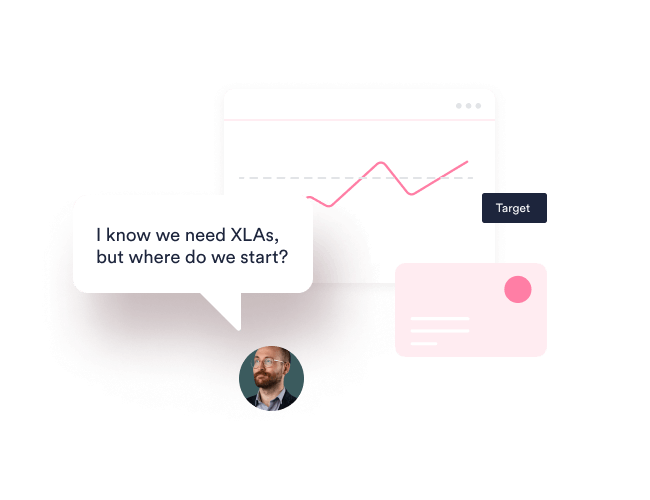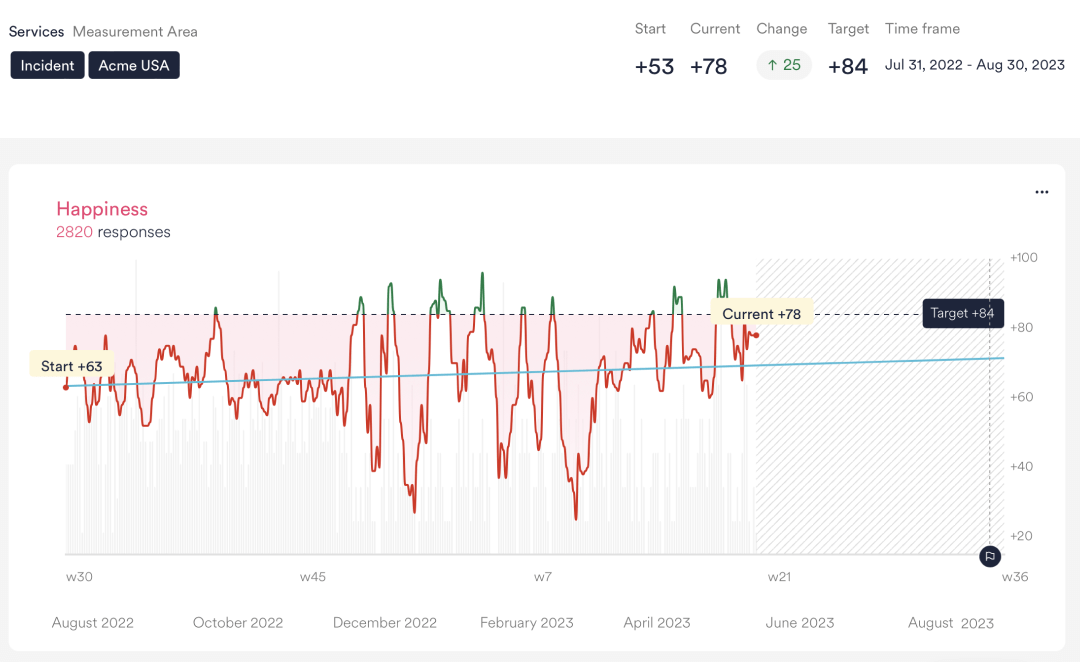Built-in XLA Management
Our platform has a native XLA support, learn more
So you’ve realized you need to have XLAs to expose the watermelon effect and change how you make decisions on IT service development, but how to get there? Moving the focus to XLAs means you need to start measuring, understand the current level and then start managing the experiences. Learn how to get easily started without spending lots of time or doing changes to your ITSM platform.

SLAs mainly differ from XLAs by being very operational. XLAs on the other hand are more tactical and strategic, which means they focus on the longer term improvements and outcomes.
To get started with XLAs, you first need to have data available to create them. XLAs are generally built from three different types of data:
As the name of the Experience Level Agreement (XLA) says, you cannot start your XLAs without first having Experience Data available in a continuous manner. So meaning you gather people's experiences every day, to create a continuous stream of Experience Data.
You can also think of these three things as People, Process and Technology. People consume and experience services and Technology + Process is used to run the services.
HappySignals Built-in XLA Management includes ready-made surveys to start gathering Experience Data today, learn more.
While the sentiment is a more specific evaluation of the end-users emotional response or opinion at a particular moment, experience takes a broader perspective and considers the end-users entire journey.
Both sentiment and experience are crucial in understanding and managing end-user satisfaction. By analyzing sentiment, businesses can identify immediate issues and address them promptly, while focusing on improving the overall end-user experience helps build long-term happiness and productivity.
As XLAs really focus on the outcome of IT, you cannot use sentiment monitoring as a way to create an XLA, you need the Experience Data.
"My sentiment at this moment is negative..."
Key differences:
"Remote working is an enjoyable experience for any employee in the sales team"
Key differences:
To be able to set XLAs you need to start measuring Experiences as soon as possible, since you need to first set up a baseline.
Baseline could be for example 2 months worth of Experience Data. When you have this data, then you can start to think about setting XLAs.
Combining the Experience Data with Operational Data allows you to set the XLA to a specific area, vendor, service, or whatever your goal is. That is why a combination of your ITSM platform's Operational Data is needed to be combined with the Experience Data from the end-users.
For example ”Set an XLA for 1st Level Service Desk provided by Vendor A” or ”Set an XLA for Remote Working for Sales Teams”. What ever your goal is you can do that with just having Experience and Operational Data combined.

Now you are ready to set Experience Targets and start doing XLA Management.
Each XLA should have a target that you are aiming to. This can either be a level to keep or level to aim at. Unlike SLAs, we would suggest having a level to aim at and reward teams for getting to those levels instead of penalizing for not keeping a certain level. Goal is to improve, not to sustain.
HappySignals ITXM platforms give you all the tools out-of-the-box to start your XLA journey.
XLAs are based on Experiences and those change based on peoples expectations and learnings from their personal lives, like social media and customer interactions with consumer brands. You need to have a practice where you review and manage the expectation you have from your XLAs. Good Practice is to set up an Experience Management Office (XMO) that regularly reviews experience data and makes the needed updates.
Besides what is measured with XLAs, the management of XLAs is the biggest difference. Continuously reviewing, updating and managing your XLAs is a practice you need to take into use.
Good practice to manage XLAs is to set up an Experience Management Office (XMO).
Tooling that makes all this work easy and real-time helps, that's why HappySignals has the built-in XLA Management features.
Implementing XLAs doesn't mean you must completely scrub out existing IT service management (ITSM) processes or service level agreements (SLAs). You can easily complement your existing set-up with experience level agreements (XLAs). The critical distinction is to focus on people, process, and technology... in that order.
|
Learn how the HappySignals Platform can help you to:
|
Align IT to outcomes
You’re successful in your role when IT focuses on delivering tangible outcomes for end-users rather than mere process or technology outputs.Make experience the goal of IT
You can get a real-time view of end-users experiences across different support functions in your organization. Accelerate the adoption of XLAs with reliable and repeatable Experience Data from HappySignals, combined with your expertise in experience.
The platform enables a strategic, proactive approach to ensure people and culture are at the start of business discussions.
Make employees more productive
As a Service Owner, you can use XLAs and experience data to create alignment between different roles and vendors that impact the area of your responsibility.
Using HappySignals as a shared view with all stakeholders allows you to align vendors/MSPs to deliver valuable end-user outcomes for the organization.
Give meaning to Service Desk work
You can create an end-user-centric focus by sharing the Experience Data in real-time with everybody on the service desk.
78% of feedback from end-users among HappySignals customers is positive. Seeing that will increase service agent motivation and job satisfaction, improving the experiences your agents deliver to end-users.
Align IT to outcomes
You’re successful in your role when IT focuses on delivering tangible outcomes for end-users rather than mere process or technology outputs.Make experience the goal of IT
You can get a real-time view of end-users experiences across different support functions in your organization. Accelerate the adoption of XLAs with reliable and repeatable Experience Data from HappySignals, combined with your expertise in experience.
The platform enables a strategic, proactive approach to ensure people and culture are at the start of business discussions.
Make employees more productive
As a Service Owner, you can use XLAs and experience data to create alignment between different roles and vendors that impact the area of your responsibility.
Using HappySignals as a shared view with all stakeholders allows you to align vendors/MSPs to deliver valuable end-user outcomes for the organization.
Give meaning to Service Desk work
You can create an end-user-centric focus by sharing the Experience Data in real-time with everybody on the service desk.
78% of feedback from end-users among HappySignals customers is positive. Seeing that will increase service agent motivation and job satisfaction, improving the experiences your agents deliver to end-users.
